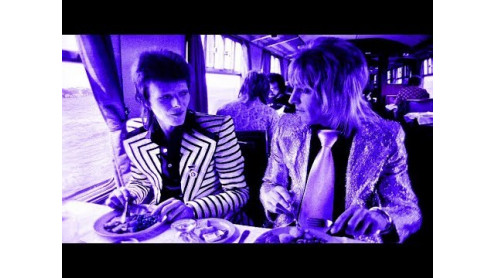
Michael Bierut: Design Is Democratic08.10.2018
One of the most renowned and important graphic designers in the world. Disciple of the legendary designer Massimo Vignelli and member of the highly acclaimed design firm Pentagram. Today, he’ll speak to us about his inspirations and his work for Hillary Clinton.
The Karakter publishing house has just released the Polish translation of your essay anthology, Now You See It and Other Essays on Design. Who’s the book intended for?
I wrote the book not only for designers, but also people who give matters of design a rather wide berth. The book explores the universal nature of design and how to give it an international reading. Besides, I’m a middle-aged graphic designer with considerable professional experience, and I believed my essays could help artists break out of their rut or at least offer interesting insights to those who saw themselves as wholly uninterested in design matters. The essays are a portal to the world of design as it was in the eighties, the nineties, and the aughts, and although it may seem immodest of me, it seems that I have managed to produce a volume on cultural anthropology.
Have you ever had any experience with Polish design?
Although I was fascinated with Polish filmmaking back then, I consider my discovery of the Polish school of poster art the defining experience of my college years. Despite not knowing the language, I kept looking for new posters, endlessly fascinated with the allegorical model of film promotion they were creating. I believe that the artists behind these posters had a much better knowledge of the applied arts than us Americans. Although I’ve never been to Poland myself, my grandparents were of Polish descent. I know my grandmother would certainly be proud of the fact that I managed to find an audience in Poland.
Have you noticed any significant shifts in graphic design work since you started in the industry? Has creative work looked any different in the past?
The design process has always been and will always be very complex. Nowadays, whenever I begin working on a commission, the process looks more or less the same it has ten or twenty years ago. It goes something like this: I set up a meeting with my coworkers, we talk the project over, discuss pros and cons. It’s important for design to coexist rather seamlessly with reality, rather than be separate from it. Technology merely allows us to act faster. Some things, however, never change, including the early stages of working on a project—to this very day I begin by picking up a felt-tip pen, a piece of paper, and staring out into space. The pacing of the process is much quicker nowadays, and ideas evolve at an astonishing rate. That, however, is mostly the clients’ doing. What once took whole weeks today unfolds over a couple of hours.
Are there any designs or logos out there you would consider revolutionary or groundbreaking?
When I start out designing a logotype, I always the QUARK logo that I saw from my room in my childhood home. As a young boy, I stared for that logo for hours on end, tracing its shape in my mind. It was that logo that inspired me to take up creative work—I kept coming back to it throughout the years and dreamed of ultimately creating something equally powerful.
I often pondered the power that a designer working on a logotype ultimately wields—his work is supposed to clearly communicate its message throughout its entire lifespan. A logo has to be simple and yet highly abstract—so that everyone can interpret them in their own individual way. I believe the Nike swish and the Apple logo to be one of the most revolutionary logotypes in history—and both are very simple.
Which of your works is especially important to you?
The logo I designed for Hillary Clinton’s presidential run has been making some waves recently. The logotype was supposed to be simple in order to preclude unnecessary discussions that could obscure its message. My primary goal was to design a neutral logo, something that, paradoxically, basically anyone could have come up with. The design process resembled baking cookies—it was homely, relaxed.

How does design shape our reality? Do you think that surrounding ourselves with good and interesting design can ultimately change our world for the better?
Oh, absolutely. I feel that the world nowadays is designed much better than it was some time ago. Regardless of where you are and what circles you move in, you can clearly see the influence of design on nearly everything around us, from cities to national parks. Even the way we communicate and speak to one another has been affected by design and its far-reaching influence. Design affects how we move around (through Uber) and how we date (through dating apps). We’ve basically arrived at a point where everything around us is a meticulously designed experience. I believe that brand loyalty is motivated primarily by design and its impact. The whole thing seems somewhat mystical, but my age dictates I maintain a healthy skepticism about the matter. Nowadays, I believe it to be crucial for design to remain democratic, unwilling to manipulate, and to offer us plenty room to grow.
see also
- Chris Duffey | The 4 E’s of Enhanced Creativity Framework

Opinions
Chris Duffey | The 4 E’s of Enhanced Creativity Framework
- Europe to Ban Single-Use Plastics from 2021

News
Europe to Ban Single-Use Plastics from 2021
- Filip Bartczak: Balance interrupted
 Papaya Films
Papaya FilmsPeople
Filip Bartczak: Balance interrupted
- Eco-Security Forces, Meeting with Ghosts and Influencers' therapy. Here Come The Winners of Papaya Rocks Film Festival
 Papaya Rocks Film Festival
Papaya Rocks Film FestivalNews
Eco-Security Forces, Meeting with Ghosts and Influencers' therapy. Here Come The Winners of Papaya Rocks Film Festival
discover playlists
-
John Peel Sessions
 17
17John Peel Sessions
-
George Lucas
 02
02George Lucas
-
Nagrody Specjalne PYD 2020
 02
02Nagrody Specjalne PYD 2020
-
Branded Stories PYD 2020
 03
03Branded Stories PYD 2020
